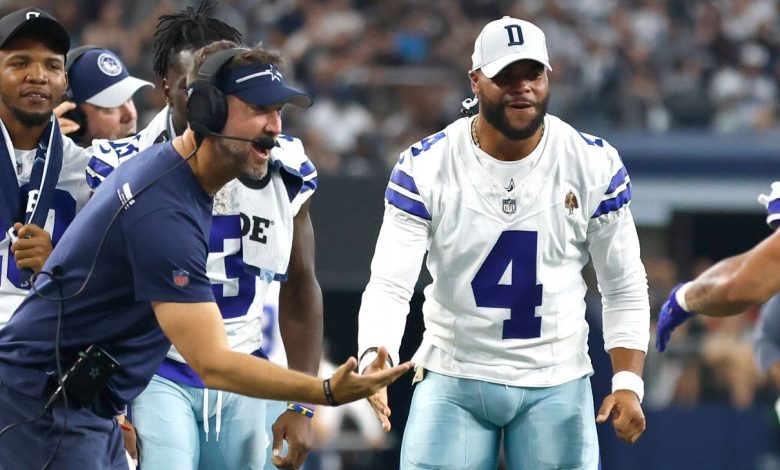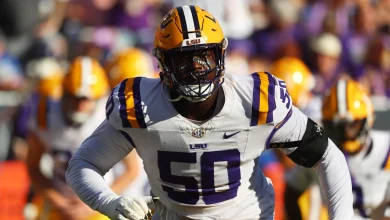The Dallas Cowboys have a new offensive strategy led by Dak Prescott.

In the ever-evolving world of the NFL, the Dallas Cowboys have continuously looked to adapt and stay ahead of the curve. Under the leadership of quarterback Dak Prescott, the team has turned to a new offensive strategy that aims to capitalize on Prescott’s unique skill set, the evolving dynamics of the NFL, and the changing landscape of modern football. As the Cowboys gear up for another season, their offensive approach is being reshaped to ensure they remain competitive and dynamic, particularly in a league that is becoming more fast-paced and pass-heavy with each passing year.
While the Cowboys have been traditionally known for their strong running game, led by figures like Emmitt Smith, and a steady offensive line, the emergence of Dak Prescott has led the team to explore a more balanced, pass-oriented offense. This shift is a direct response to the NFL’s increasing reliance on passing and the need for a quarterback who can read defenses, make quick decisions, and execute in the clutch.
This article will explore the key elements of the new offensive strategy for the Dallas Cowboys, the role of Dak Prescott in its execution, and what this change means for the team’s future.
Dak Prescott: The Heart of the New Offense
Dak Prescott’s importance to the Dallas Cowboys cannot be overstated. Since being drafted by the Cowboys in the fourth round of the 2016 NFL Draft, Prescott has become the centerpiece of the team’s offense, and his ability to perform under pressure has been critical to the team’s success. Prescott has shown an exceptional ability to lead his team through both the highs and lows of NFL seasons, developing into one of the league’s top quarterbacks.
Prescott’s strengths lie in his dual-threat capability. As a mobile quarterback, he can extend plays with his legs, providing an added dimension to the Cowboys’ offensive attack. This mobility has allowed Prescott to avoid sacks and pick up crucial first downs when the pocket breaks down. His arm strength, accuracy, and ability to make deep throws further enhance his versatility, making him a constant threat in both short and long-range situations.
Prescott’s leadership on the field and his decision-making ability are another aspect that sets him apart. Throughout his career, he has demonstrated an ability to maintain poise in high-pressure moments, whether it’s during a late-game comeback or in an early-season matchup against a tough opponent. This quality has endeared him to Cowboys fans and coaches alike, cementing his role as the central figure in the team’s offense moving forward.
The Shift Toward a Pass-Heavy Offense
In recent years, the NFL has seen a shift toward pass-heavy offenses, with teams looking to capitalize on high-scoring, fast-paced plays. The rise of quarterbacks like Patrick Mahomes, Lamar Jackson, Josh Allen, and Kyler Murray has highlighted the importance of a dynamic passing attack. As the game evolves, more teams are focusing on creating an offense that can score quickly, put up yards, and keep opposing defenses on their heels. This change is particularly evident in the NFC East, where division rivals have also turned to pass-first offenses to compete at a high level.
For the Cowboys, this shift to a more pass-heavy offensive strategy comes after years of emphasizing a strong running game, anchored by running backs like Ezekiel Elliott. However, the team has realized that with Prescott’s talent, a more balanced approach that leans on the quarterback’s abilities as a passer can provide a more sustainable and effective offensive attack. The goal is not to abandon the run game completely, but to leverage Prescott’s skill set to create a more diverse and unpredictable offense that keeps defenses guessing.
Head coach Mike McCarthy, who took over the Cowboys’ coaching job in 2020, has embraced this transition to a more modern, pass-oriented offense. McCarthy’s experience as the head coach of the Green Bay Packers, where he helped develop the passing attack around Aaron Rodgers, has informed his approach to Dallas’s offensive scheme. Under McCarthy’s guidance, the Cowboys are beginning to implement more West Coast principles, including quick passes, play-action, and a greater emphasis on spreading the ball around to multiple receivers.
With Prescott leading the charge, the Cowboys are focusing on the vertical passing game, attacking defenses down the field with deep throws and challenging the secondary. This approach is in contrast to previous years, when the offense often relied on short, quick passes and a steady diet of running plays. The hope is that this more dynamic, pass-first approach will keep the opposing defenses off balance and force them to defend both the run and the pass.
Key Components of the New Offensive Strategy
1. Dak Prescott’s Growth and Development
At the center of this new offensive strategy is Dak Prescott himself. Prescott’s growth as a quarterback has been evident throughout his career, and the changes to the Cowboys’ offense are a direct reflection of his maturation as a leader and a passer.
Prescott’s mechanics have continued to improve, with particular emphasis on his footwork and his ability to read defenses post-snap. The quarterback’s ability to make quick decisions in the pocket and his willingness to take risks down the field are vital components of the Cowboys’ new offensive identity. By developing a more complex understanding of defensive coverages and anticipating where his receivers will be, Prescott has become more comfortable throwing into tight windows and managing the flow of the game.
Moreover, Prescott has developed better chemistry with his receivers, particularly with stars like Amari Cooper, CeeDee Lamb, and Michael Gallup. This trio of wideouts is one of the most talented receiving corps in the NFL, and their ability to stretch the field will be key in executing the Cowboys’ new pass-heavy strategy. Prescott’s rapport with his receivers has allowed the Cowboys to expand their playbook, incorporating more deep passing routes and creative formations to keep the defense guessing.
2. The Run-Pass Balance
While the Cowboys are making the shift toward a more pass-heavy offense, the team is still committed to maintaining a strong running game, especially with Ezekiel Elliott in the backfield. The balance between the pass and the run is critical to keeping defenses honest and preventing them from loading up against the pass.
Elliott, who has been the team’s cornerstone running back since he was drafted in 2016, remains a dynamic threat on the ground. Even though the Cowboys are becoming more pass-oriented, Elliott’s ability to break tackles and pick up yards after contact makes him a valuable weapon. His role in the offense is also important in terms of play-action, where his threat as a rusher can help to create opportunities for Prescott to make deep passes.
For the Cowboys, the ability to blend a powerful run game with an explosive passing attack is a crucial element in creating a multifaceted offense that can attack from multiple angles. By keeping defenses honest with a balanced approach, the Cowboys ensure that they can execute their offensive strategy effectively, whether through the air or on the ground.
3. Play-Action and Motion
One of the hallmarks of the Cowboys’ new offensive approach is their reliance on play-action and motion to manipulate defenses. Play-action, in particular, allows Prescott to fake a handoff and then quickly move into a passing rhythm, providing him with more time to read the defense and find open receivers. This tactic not only keeps defenses on edge but also opens up space in the intermediate and deep passing lanes.
Motion, which involves shifting players before the snap, is another tool the Cowboys will use to create mismatches and confusion for defenders. By moving their receivers and tight ends pre-snap, they can get a better idea of what type of defense the opposition is playing. This information allows Prescott to make better decisions based on defensive alignments and coverage, leading to more efficient and productive offensive drives.
4. Maximizing the Potential of the Receiving Corps
The Cowboys’ receiving corps is one of the most talented in the NFL, and maximizing its potential will be key to the team’s offensive success. With Amari Cooper, CeeDee Lamb, and Michael Gallup, the Cowboys have a deep and diverse group of playmakers who can make an impact both in the short and long game.
Cooper, a seasoned veteran, brings precise route-running and hands that rarely drop passes. Lamb, who has emerged as one of the NFL’s most exciting young talents, possesses the ability to make plays all over the field, from intermediate routes to explosive deep balls. Gallup, known for his speed and ability to stretch the field, adds a dangerous vertical threat to the offense. These three receivers complement each other perfectly, giving Dak Prescott a multitude of options on every play.
In addition to the wideouts, the Cowboys also boast one of the most talented tight end groups in the league, including players like Blake Jarwin and Dalton Schultz, who provide Prescott with reliable targets in both the passing game and as blockers in the running game.
The Impact of the New Strategy
The shift toward a pass-heavy offense, with Dak Prescott at the helm, represents a critical evolution for the Dallas Cowboys. It allows the team to fully tap into the talent of their quarterback and receiving corps, and it sets the stage for more explosive, high-scoring games. This approach also reflects the broader trend in the NFL, where passing offenses have increasingly taken precedence over traditional run-heavy systems.
The new offensive strategy is designed to maximize Prescott’s strengths and capitalize on the versatility of the Cowboys’ skill players. With a balanced attack that features a powerful running game paired with a potent passing game, the Cowboys are positioning themselves to compete at the highest level in the NFC and beyond.
For Dak Prescott, this shift represents a significant opportunity to solidify his place among the elite quarterbacks in the NFL. As he continues to refine his game and build chemistry with his teammates, Prescott has the potential to lead the Cowboys to the promised land, both through his leadership and his ability to execute the team’s dynamic offensive scheme.
In conclusion, the Dallas Cowboys’ new offensive strategy led by Dak Prescott is an exciting and promising development for the team’s future. With the right balance between the run and the pass, and the leadership of Prescott, the Cowboys are poised to be a formidable force in the NFL for years to come.









